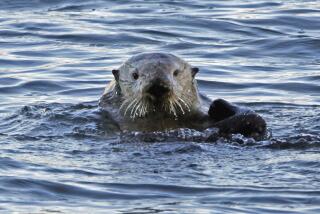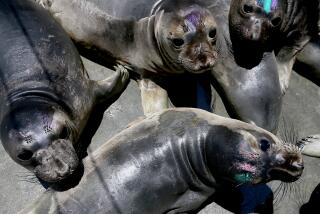South Bay beaches hit by swarms of kelp flies
June gloom might not be the only thing keeping people away from beaches in the South Bay this weekend.
Swarms of black kelp flies — scientifically known as Coelopa frigida — have invaded beaches in Torrance, Redondo Beach, Manhattan Beach and Hermosa Beach, covering trash cans and lifeguard stands and annoying visitors.
Though the flies are typically found in Redondo Beach near the rock-laden Topaz Street jetty, lifeguards said, there are definitely more this year.
“We’ve seen blooms in the past,” said Garth Canning, a section chief with the Los Angeles County Fire Department’s Lifeguard Division. But this year the numbers “are very obviously greater, and they’re extending over a larger area than they usually do,” he said.
According to Oceana, an international marine conservation organization, kelp flies are common along North Pacific shorelines.
The flies are attracted to dead kelp that washes up on shore, said Brian Brown, curator of entomology at the Natural History Museum of Los Angeles County. This is where the flies lay their eggs, and the larvae that hatch feed on the decaying kelp, helping to break it down.
Though he has not seen the swarms firsthand, Brown said a number of factors could have contributed to the increase.
“Sometimes there’s large amounts of kelp on the beach, or it could be because it’s spring and the temperatures are starting to warm up,” Brown said. “Especially the warmer temperatures — that’s what really drives the flies.”
There are no plans to spray pesticides or otherwise try to kill the insects, which have a life cycle of about 11 days after eggs are laid.
“They have a very short life cycle, so there isn’t really a lot to do,” Brown said. “This will ebb and flow on its own.”
Area beachgoers said they’ve seen the insects, and it’s not a pretty sight.
“I’ve definitely noticed them around the kelp patches — big swarms of them congregating around,” said Sam Osborn, who lives in Manhattan Beach. “They’re thick, black clumps of flies. It’s really gross.”
Osborn has seen them while surfing in Manhattan Beach, including at El Porto beach, which abuts El Segundo.
Area marinas have managed to avoid the problem because dead kelp is not found on the docks, said Leslie Page, property manager and dock master for the Redondo Beach Marina.
“Our kelp stays in the water, so we don’t have the eggs and flies,” she said. “I don’t need any flies on the marina.”
Though beachgoers might be annoyed by the bugs, Brown said the flies pose no real danger.
“It’s just a nuisance problem,” he said.
More to Read
Start your day right
Sign up for Essential California for news, features and recommendations from the L.A. Times and beyond in your inbox six days a week.
You may occasionally receive promotional content from the Los Angeles Times.







